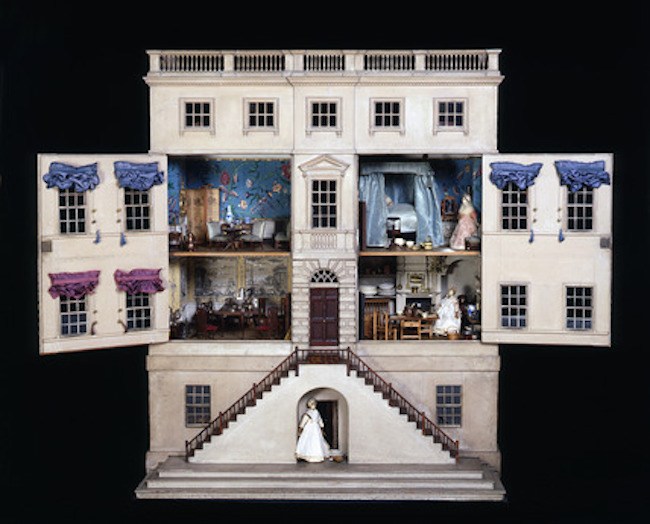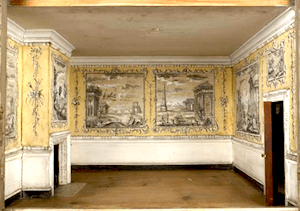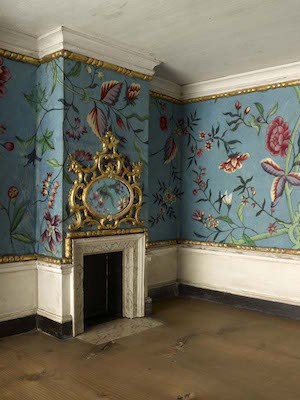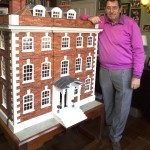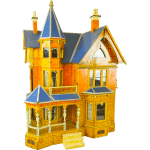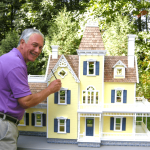The Blackett Baby House
This Queen Anne style dolls house is on permanent exhibit at the Museum of London. It is believed to have been a gift by Sir Edward Blackett to his wife, Anne, on the birth of their two younger children William and Mary c.1758. The dolls’ house was presented to the museum in 1912 by Ida Frances Blackett, a great-granddaughter of Sir Edward and Lady Anne Blackett. The following is extracted from the Museum website.
Baby house
The Blackett family owed their fortune to coal and lead mining interests in Northumberland and County Durham. This dolls’ house was originally owned by Lady Anne Blackett, wife of Sir Edward the 4th Baronet. Edward may have given his wife this dolls’ house as a gift to celebrate the birth of their son William and daughter Mary in 1758. The couple were married in 1751 and lived at Matfen Hall, Anne’s family home in Northumberland. They had two other children, twins also named Edward and Anne, who were born in 1752. The Blacketts were a landowning provincial gentry family, but also had links with London through Edward’s involvement in commerce and politics. Edward served as MP for Northumberland between 1768 and 1774. The family frequently traveled south to their second home in Thorpe Lea, Surrey.
Blackett baby House Dining Room’Baby houses’ as they were known in this period, were commissioned by wealthy families as social status symbols. They were often made as miniature replicas of real houses or featured elements of them. Baby houses were made for adults to display in drawing rooms rather than for children to play within nurseries. Dolls’ houses as toys were an advent of the late eighteenth century, although Anne’s great-granddaughter Evelyn later recalled that even in her time, the Blackett children were not allowed to play with the dolls’ house. In Anne’s era, parents would sometimes use these miniature houses to prepare their children for domestic life. She may have used it to educate her daughters on how to run a large country household.
The Blacketts’ baby house is not based directly on Matfen Hall but provides an accurate picture of contemporary furnishings in a house belonging to a family of their social background. Elements of the façade do recall another Blackett family residence, Newby Hall at Ripon, Yorkshire. Aspects of the interiors also reflect the family’s fashion-conscious tastes, which were no
doubt encouraged by Edward’s metropolitan connections. In the eighteenth century, London shops began to sell furniture and other accessories for dolls’ houses. Some of the furnishings in this baby house are later additions, perhaps collected by Lady Anne or by her descendants. Others are more crudely made, presumably replacements for broken originals. Certain furnishings, such as the silverware in the dining room, are of a disproportionate size to their surroundings adding a surreal quality to the interiors.
The house’s pine façade is in the Palladian style and opens outwards to reveal silk curtains on the windows inside. These can be drawn using a cord. The basement and the attic rooms can be accessed through side doors. The dining room downstairs features hand-painted walls depicting an Italian landscape with classical ruins. The drawing room and the bedroom on the first floor are covered by wallpaper patterned with a fashionable Chinese-style flower motif. In the drawing-room, a tea table and a screen can be seen. The screen is decorated with reproductions of playing cards illustrating Aesop’s Fables. These are taken from a pack that was on sale in a toy shop in St Paul’s Churchyard, London, at Christmas 1759. The kitchen downstairs features a working spit roasting mechanism over the hearth. The dolls in the basement doorway and the kitchen are dressed as servants; the one in the bedroom is perhaps supposed to be the lady of the house. The dolls’ house was given to the London Museum by Ida Blackett in 1912.”
More About The Family
The Blackett ancestral home was Woodcroft Hall in Upper Weardale, County Durham, in England. They lived here for at least four hundred years. The family began with Richard Blackheved, the forester of Weardale, who resided at Woodcroft until his death in 1349 when the worst recorded case of the Black Death in Britain reached the area.
Bubonic plague was not the first scourge to reach Weardale. These were killing fields for the battles between the King of the Scots, Robert The Bruce, and King Edward III.
While the Blackett spiritual home may be at Woodcroft, Richard Blackheved, wealthy descendant, the Blacketts of Newcastle, held vast lands and coal and lead mining interests. The family produced leaders in commerce, politics, and a Nobel Prize winner (Patrick Blackett, physics).
Susan Downing, with Patrick Owens
_________________________________________________________________________
I invite you to visit my Etsy Shop where I offer many accessories and pieces of furniture in 1:12 scale.


